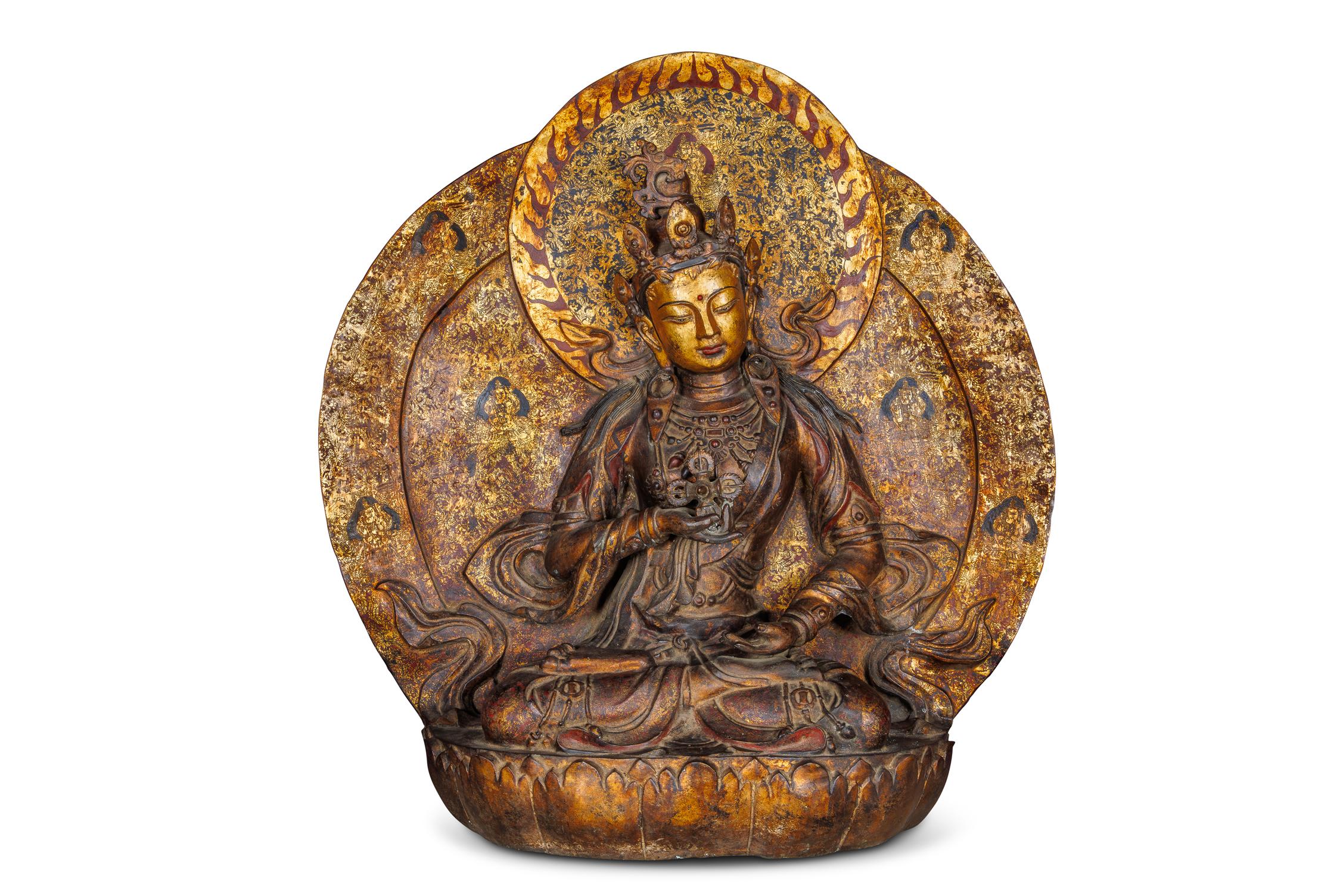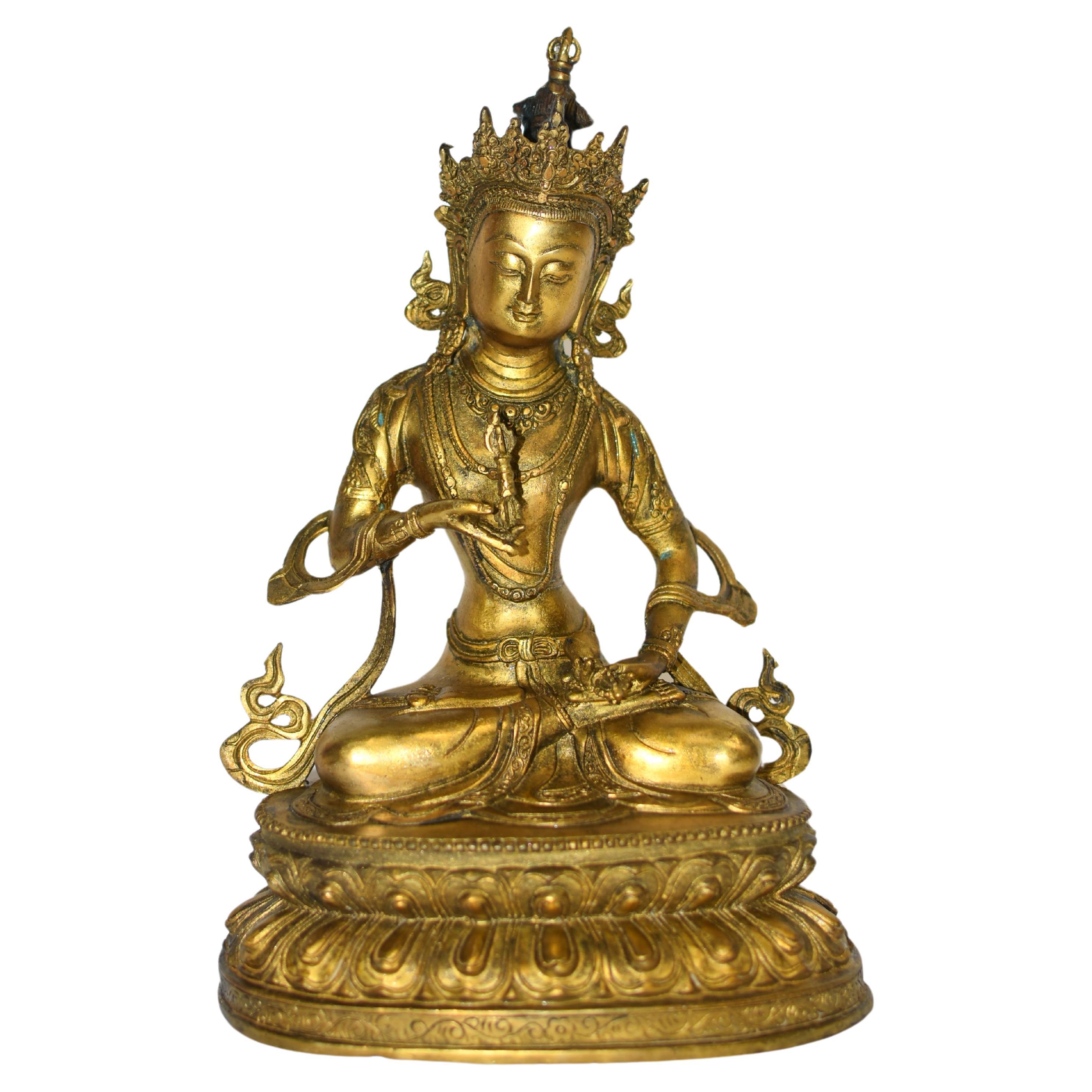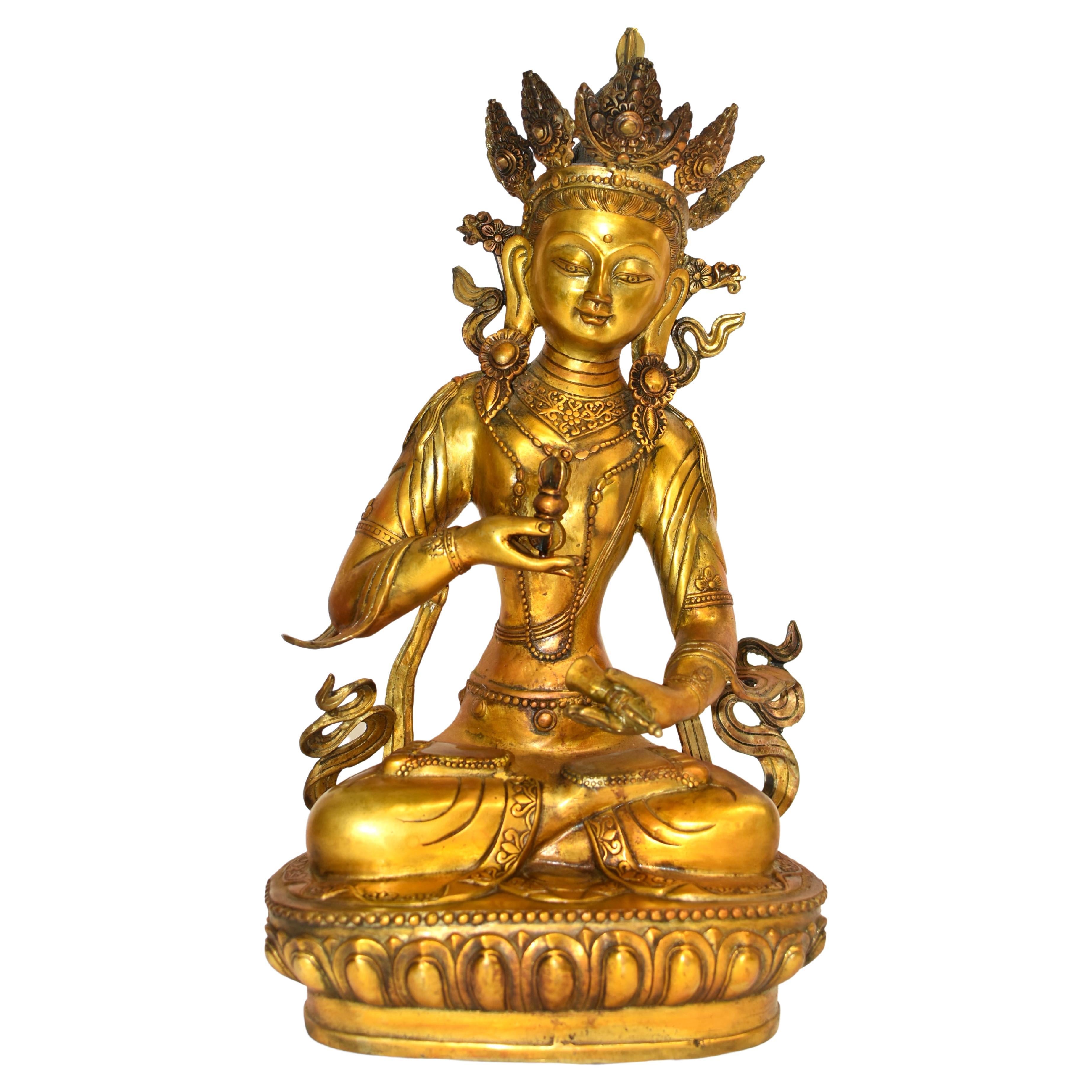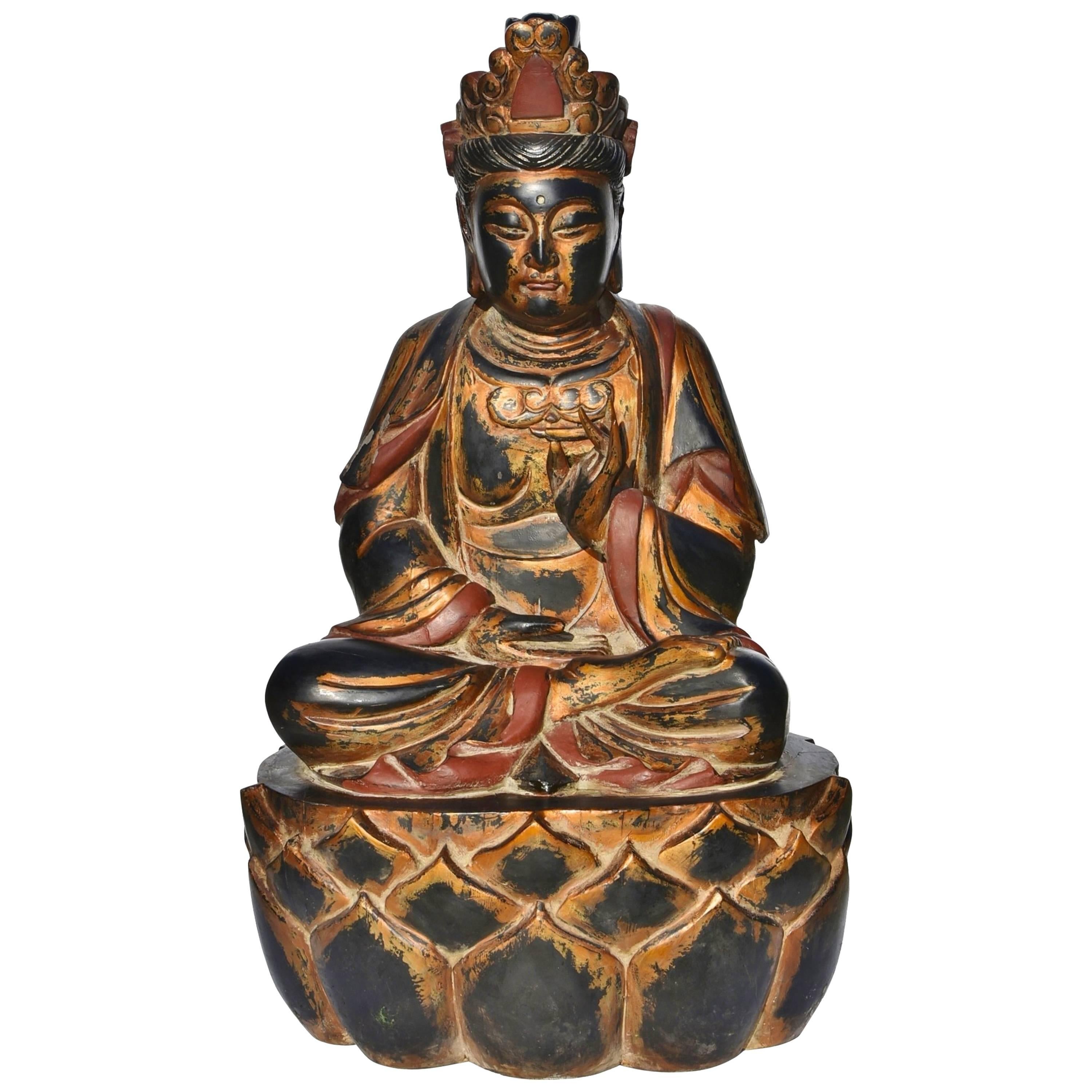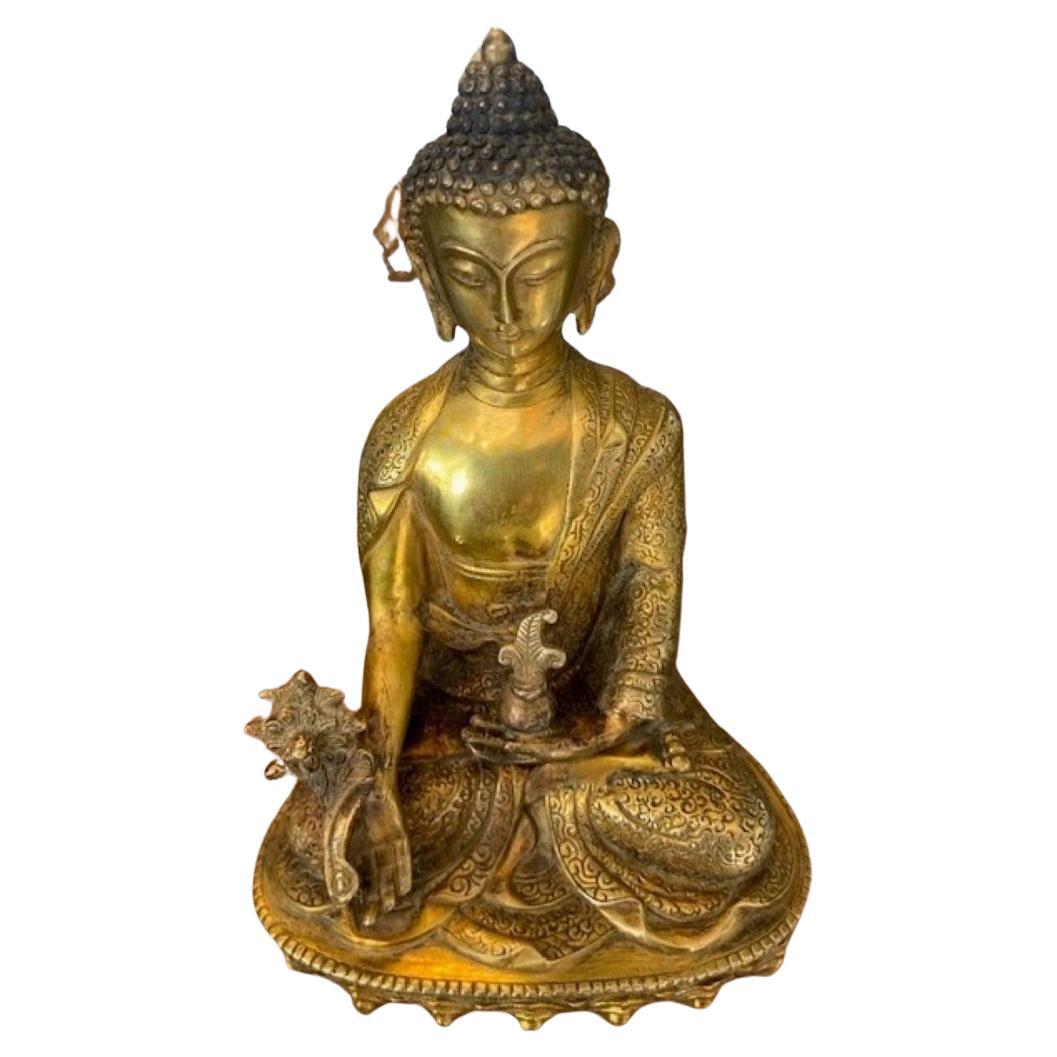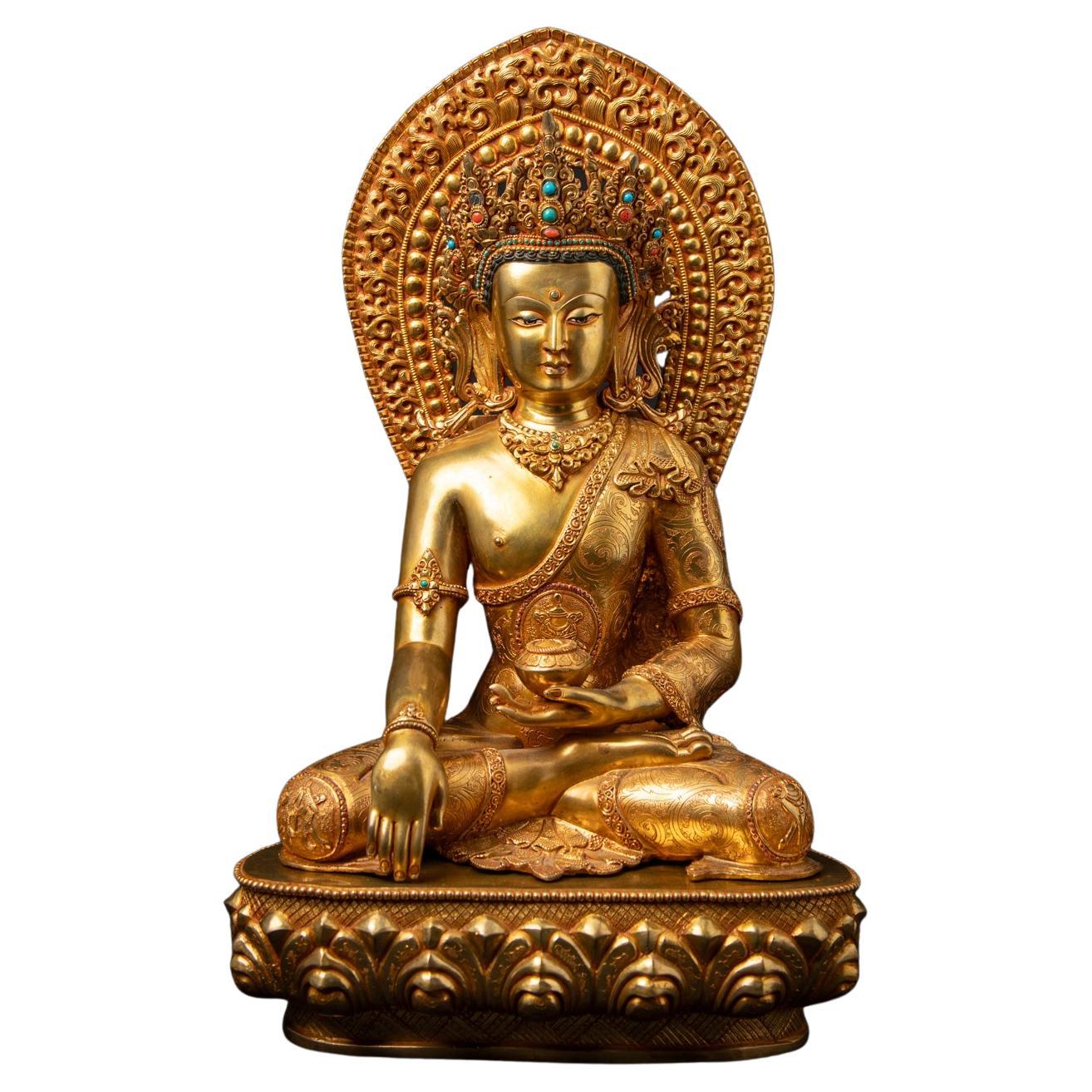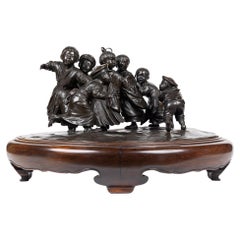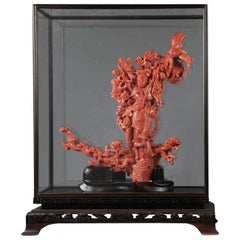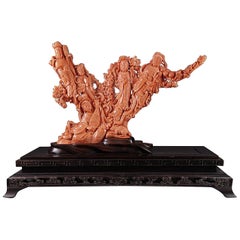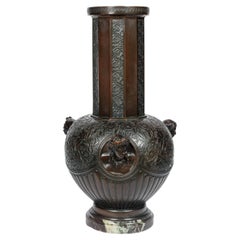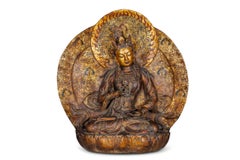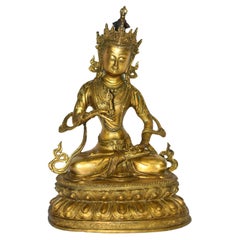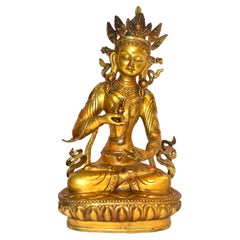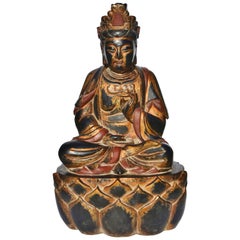Items Similar to A Monumental Gilt-Lacquered Bronze Ornamental Buddha Sculpture of Vajravidarana
Video Loading
Want more images or videos?
Request additional images or videos from the seller
1 of 12
A Monumental Gilt-Lacquered Bronze Ornamental Buddha Sculpture of Vajravidarana
Price Upon Request
Price Upon Request
Price Upon Request
Price Upon Request
Price Upon Request
Price Upon Request
Price Upon Request
Price Upon Request
Price Upon Request
Price Upon Request
Shipping
Retrieving quote...The 1stDibs Promise:
Authenticity Guarantee,
Money-Back Guarantee,
24-Hour Cancellation
About the Item
A Monumental Gilt-Lacquered Bronze Ornamental Buddha Sculpture of Vajravidarana:
A Masterpiece of Sino-Tibetan Craftsmanship, Late 19th Century, Qing Dynasty
This monumental gilt-lacquered bronze ornamental sculpture of Vajravidarana is an extraordinary and commanding piece of art, showcasing the pinnacle of Sino-Tibetan craftsmanship from the late 19th century. The figure of Vajravidarana, a powerful purification deity in Tibetan Buddhism, is meticulously sculpted to embody both spiritual authority and artistic excellence.
Vajravidarana is primarily known for his role in removing spiritual impurities and negativities. Unlike other deities associated with wisdom or compassion, Vajravidarana’s function is centered on purification and healing. He is typically depicted holding a vajra and a bell, symbolizing the cutting away of delusions and the resonance of divine truth. In this striking sculpture, Vajravidarana is shown holding a vishva vajra (the double vajra), a unique and powerful variation of the traditional iconography, which signifies ultimate protection and the dispelling of negative karma.
Vajravidarana: The Supreme Purifier and Protector
Vajravidarana is revered in Tibetan Buddhism as the deity of spiritual purification, called upon to cleanse practitioners of defilements and negative influences. His vajra represents the indestructibility of truth, while his bell signifies the wisdom that resonates through purification rituals. In this sculpture, the presence of the vishva vajra, or double vajra, enhances his association with supreme protection, ensuring the destruction of all spiritual obstacles and afflictions.
The figure’s powerful yet composed expression conveys a sense of unwavering resolve and divine authority. His posture, along with the carefully sculpted details of his robes and ornaments, highlights his function as a guardian against impurity. The inclusion of the vishva vajra rather than the usual single vajra reinforces his role as a supreme protector, capable of dispelling all forms of negativity and restoring balance.
Symbolism of the Mantras and Aureole:
Unlike deities that embody wisdom through duality, Vajravidarana’s iconography is centered on purification and exorcism. The aureole surrounding him is inscribed with sacred purification mantras rather than depictions of a consort. These mantras emphasize his function as a remover of obstacles and impurities, reinforcing his role in Buddhist healing rituals.
The presence of the sacred inscriptions elevates the sculpture’s spiritual significance, making it a focal point for meditation and ritual purification. Practitioners often visualize Vajravidarana radiating purifying light, dissolving afflictions and negative karma. This theme is mirrored in the sculptural repetition of the purification symbols on the aureole, reinforcing the deity’s role as a divine cleanser.
Gilt-Lacquered Bronze: The Artistry of Sino-Tibetan Metalwork:
The craftsmanship of this monumental figure reflects the expertise of late 19th-century Sino-Tibetan metalwork, where traditional Tibetan themes were infused with Chinese artistic sensibilities. Cast in bronze and finished with a rich gilt lacquer, the statue has an otherworldly glow, giving it an ethereal, almost divine presence. The gilding process—applied with exceptional skill—gives the sculpture a striking luminosity that enhances the fine details of the facial features, flowing robes, jewelry, and other elements of the deity’s attire.
The technique employed to create this figure speaks to the high level of craftsmanship that flourished during the late Qing Dynasty and early modern Tibetan art. The ornate details of the robes and the fine texture of the sculpture highlight the exceptional skill of the artisans who brought this work to life. The use of gold and lacquer not only reflects the preciousness of the sculpture but also its spiritual significance as an object meant to inspire reverence and meditation.
An Ornamental Sculpture of Monumental Scale:
Unlike smaller devotional objects, this sculpture is designed as an ornamental masterpiece, intended to make a grand visual and spiritual statement. Its monumental size allows it to dominate any space, offering a commanding presence that is both physically and symbolically impressive. In Buddhist practice, large sculptures of this nature are often placed in temples or meditation halls, where their imposing size and serene presence would encourage contemplation and devotion.
The grand scale of the statue further amplifies the spiritual power it is meant to convey. As a representation of Vajravidarana, it is not only a physical object of beauty but also a conduit for meditation, purification, and enlightenment. The scale of the sculpture also emphasizes the divine stature of the deity, highlighting his importance in the Buddhist tradition as the ultimate force for spiritual cleansing and protection.
Provenance:
Acquired in China in circa 1900
1905 Private Buddhist Temple, Northeast, USA
Private Sale
Solomon Treasure, New York
43" high x 43" wide x 12" deep
Very good condition. Normal wear consistent with age and use. A truly exceptional and one of a kind piece.
**Please note this weighs approximately 250 pounds
- Dimensions:Height: 43 in (109.22 cm)Width: 43 in (109.22 cm)Depth: 12 in (30.48 cm)
- Style:Tibetan (Of the Period)
- Materials and Techniques:
- Place of Origin:
- Period:
- Date of Manufacture:19th Century
- Condition:Wear consistent with age and use.
- Seller Location:Queens, NY
- Reference Number:1stDibs: LU1798242347822
About the Seller
5.0
Vetted Professional Seller
Every seller passes strict standards for authenticity and reliability
Established in 1980
1stDibs seller since 2016
63 sales on 1stDibs
Typical response time: 5 hours
- ShippingRetrieving quote...Shipping from: Queens, NY
- Return Policy
Authenticity Guarantee
In the unlikely event there’s an issue with an item’s authenticity, contact us within 1 year for a full refund. DetailsMoney-Back Guarantee
If your item is not as described, is damaged in transit, or does not arrive, contact us within 7 days for a full refund. Details24-Hour Cancellation
You have a 24-hour grace period in which to reconsider your purchase, with no questions asked.Vetted Professional Sellers
Our world-class sellers must adhere to strict standards for service and quality, maintaining the integrity of our listings.Price-Match Guarantee
If you find that a seller listed the same item for a lower price elsewhere, we’ll match it.Trusted Global Delivery
Our best-in-class carrier network provides specialized shipping options worldwide, including custom delivery.More From This Seller
View AllA Large and Exceptional Japanese Meiji Period Tokyo School Bronze Sculpture
Located in Queens, NY
Presenting an extraordinary Large and Exceptional Japanese Meiji Period Tokyo School Bronze Sculpture depicting a delightful ensemble of six energe...
Category
Antique 19th Century Japanese Meiji Sculptures and Carvings
Materials
Bronze
$37,050 Sale Price
35% Off
Exceptional Chinese Carved Coral Figural Group of a Guanyin Kwan Yin Phoenix
Located in Queens, NY
An exceptional Chinese carved coral figural group of a Guanyin, Kwan Yin with a Phoenix.
Very finely carved. In a custom made glass...
Category
Early 20th Century Chinese Sculptures and Carvings
Materials
Coral
Exceptional Large Chinese Carved Coral Figural Group Statue of Female Immortals
Located in Queens, NY
An exceptional and large Chinese carved coral figural group / statue of female Immortals.
Very finely carved, very large and heav...
Category
Early 20th Century Chinese Sculptures and Carvings
Materials
Coral
A Majestic and Monumental Patinated Bronze Vase With Regal Roman Emperors
Located in Queens, NY
A Majestic and Monumental Patinated Bronze Vase With Regal Roman Emperors, 19th Century
Step into the world of ancient Rome with this monumental patinated bronze vase, a breathtakin...
Category
Antique 19th Century Vases
Materials
Marble, Bronze
Exceptional Chinese Carved Coral Figural Group of a Boat with Eight Immortals
Located in Queens, NY
An exceptional Chinese carved coral figural group or statue of a boat with eight immortals. The boat in a form of a carved dragon wi...
Category
Early 20th Century Chinese Sculptures and Carvings
Materials
Coral
Monumental Silvered and Gilt-Bronze Glass Centerpiece of "Poseidon"
Located in Queens, NY
A Monumental French Silvered and Gilt-Bronze and Glass Centerpiece of "Poseidon", Paris, circa 1895.
A very good quality centerpiece depicting "Poseidon and his seahorses", of mon...
Category
Early 20th Century French Classical Greek Centerpieces
Materials
Bronze
$37,500 Sale Price
50% Off
You May Also Like
A Monumental Gilt-Lacquered Bronze Ornamental Sculpture of Vajravidarana
Located in Queens, NY
A Monumental Gilt-Lacquered Bronze Ornamental Buddha Sculpture of Vajravidarana:
A Masterpiece of Sino-Tibetan Craftsmanship, Late 19th Century, Qing Dynasty
This monumental gilt-lacquered bronze ornamental sculpture of Vajravidarana is an extraordinary and commanding piece of art, showcasing the pinnacle of Sino-Tibetan craftsmanship from the late 19th century. The figure of Vajravidarana, a powerful purification deity in Tibetan Buddhism, is meticulously sculpted to embody both spiritual authority and artistic excellence.
Vajravidarana is primarily known for his role in removing spiritual impurities and negativities. Unlike other deities associated with wisdom or compassion, Vajravidarana’s function is centered on purification and healing. He is typically depicted holding a vajra and a bell, symbolizing the cutting away of delusions and the resonance of divine truth. In this striking sculpture, Vajravidarana is shown holding a vishva vajra (the double vajra), a unique and powerful variation of the traditional iconography, which signifies ultimate protection and the dispelling of negative karma.
Vajravidarana: The Supreme Purifier and Protector
Vajravidarana is revered in Tibetan Buddhism as the deity of spiritual purification, called upon to cleanse practitioners of defilements and negative influences. His vajra represents the indestructibility of truth, while his bell signifies the wisdom that resonates through purification rituals. In this sculpture, the presence of the vishva vajra, or double vajra, enhances his association with supreme protection, ensuring the destruction of all spiritual obstacles and afflictions.
The figure’s powerful yet composed expression conveys a sense of unwavering resolve and divine authority. His posture, along with the carefully sculpted details of his robes and ornaments, highlights his function as a guardian against impurity. The inclusion of the vishva vajra rather than the usual single vajra reinforces his role as a supreme protector, capable of dispelling all forms of negativity and restoring balance.
Symbolism of the Mantras and Aureole:
Unlike deities that embody wisdom through duality, Vajravidarana’s iconography is centered on purification and exorcism. The aureole surrounding him is inscribed with sacred purification mantras rather than depictions of a consort. These mantras emphasize his function as a remover of obstacles and impurities, reinforcing his role in Buddhist healing rituals.
The presence of the sacred inscriptions elevates the sculpture’s spiritual significance, making it a focal point for meditation and ritual purification. Practitioners often visualize Vajravidarana radiating purifying light, dissolving afflictions and negative karma. This theme is mirrored in the sculptural repetition of the purification symbols on the aureole, reinforcing the deity’s role as a divine cleanser.
Gilt-Lacquered Bronze: The Artistry of Sino-Tibetan Metalwork:
The craftsmanship of this monumental figure reflects the expertise of late 19th-century Sino-Tibetan metalwork, where traditional Tibetan themes were infused with Chinese artistic sensibilities. Cast in bronze and finished with a rich gilt lacquer, the statue has an otherworldly glow, giving it an ethereal, almost divine presence. The gilding process—applied with exceptional skill—gives the sculpture a striking luminosity that enhances the fine details of the facial features, flowing robes, jewelry, and other elements of the deity’s attire.
The technique employed to create this figure speaks to the high level of craftsmanship that flourished during the late Qing Dynasty and early modern Tibetan art. The ornate details of the robes and the fine texture of the sculpture highlight the exceptional skill of the artisans who brought this work to life. The use of gold and lacquer not only reflects the preciousness of the sculpture but also its spiritual significance as an object meant to inspire reverence and meditation.
An Ornamental Sculpture of Monumental Scale:
Unlike smaller devotional objects, this sculpture is designed as an ornamental masterpiece, intended to make a grand visual and spiritual statement. Its monumental size allows it to dominate any space, offering a commanding presence that is both physically and symbolically impressive. In Buddhist practice, large sculptures of this nature are often placed in temples or meditation halls, where their imposing size and serene presence would encourage contemplation and devotion.
The grand scale of the statue further amplifies the spiritual power it is meant to convey. As a representation of Vajravidarana, it is not only a physical object of beauty but also a conduit for meditation, purification, and enlightenment. The scale of the sculpture also emphasizes the divine stature of the deity, highlighting his importance in the Buddhist tradition as the ultimate force for spiritual cleansing and protection.
Provenance:
Acquired in China in circa 1900
1905 Private Buddhist Temple, Northeast, USA
Private Sale
Solomon Treasure...
Category
19th Century Figurative Sculptures
Materials
Bronze
Tibetan Protective Buddha Vajrasattva Gilt Bronze 13"
Located in Somis, CA
This gilt bronze sculpture of Buddha Vajrasattva stands as a testament to the sublime craftsmanship and spiritual significance of Tibetan Buddhist art. Weighing a substantial 7.25 po...
Category
20th Century Tibetan Sculptures and Carvings
Materials
Bronze
Large Vintage Tibetan Buddha Vajrasattva Gilt Bronze
Located in Somis, CA
A large near 11 lb gilt bronze sculpture of Tibetan Vajrasattva. Seated padmasna on lotus throne, the Great Vajrasattva has large downcast eyes and pendulous earlobes, an urna on his...
Category
20th Century Tibetan Sculptures and Carvings
Materials
Bronze
Giant 37" Wooden Gilded Buddha Statue
Located in Somis, CA
A magnificent gilded giant statue of Amitabha Buddha, carved from a single block of solid wood. Seated dhyana asana on a high lotus throne, the Buddha's full and round face, hallmark...
Category
20th Century Chinese Tang Sculptures and Carvings
Materials
Wood
Chinese Gilt Bronze Buddha Figure
Located in Palm Beach, FL
Chinese Gilt Bronze Buddha Figure
7 7/8 H X 3 3/8 D
Category
Antique 19th Century Asian Chinese Export Figurative Sculptures
Materials
Bronze
Very high quality large bronze Nepali Buddha - OriginalBuddhas
Located in DEVENTER, NL
Experience the beauty of traditional Nepali craftsmanship with this very high-quality large bronze Buddha statue, a stunning piece meticulously fire-gilded with 24-karat gold. Standing 49.6 cm high, 30.5 cm wide, and 21 cm deep, this exquisite statue weighs 10.1 kgs and is adorned with real gemstones for an added touch of elegance.
Depicting Buddha in the Bhumisparsha Mudra, a powerful gesture symbolizing enlightenment, this masterfully crafted Nepalese statue...
Category
21st Century and Contemporary Nepalese Sculptures and Carvings
Materials
Bronze
